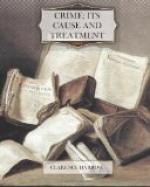A large part of the community has always attributed many criminal acts to intoxicating drinks. I am convinced that with such crimes as murder, burglary, robbery, forgery and the like, alcohol has had little to do. Petty things, like disorderly conduct, are often caused by intoxicating liquor, and these land a great many temporarily in jail, but these acts are really not criminal. Men have been temporarily locked up for over-drinking. If over-eating had been treated the same as over-drinking, the jails would often be filled with gluttons. As to health, probably the glutton takes the greater chance. A very large percentage of deaths would have been materially delayed except for excessive eating. The statements ascribing crime to intoxicating drinks have generally been made by those who are obsessed with a hatred of alcohol. As a rule if one lands in prison and has not been a total abstainer, his downfall is charged to rum. Statistics have been gathered in prison often by chaplains who, in the main, are prohibitionists and interested in sustaining an opinion. The facts are mainly furnished by inmates of prisons, a poor source from which to gather facts and draw deductions, especially as to the cause of crime. Prisoners are interested in only one thing, and that is getting out. They understand perfectly well what kind of statistics the chaplain wants and these are given. It is the nature and part of the protective instinct of everyone to find some excuse for his acts. Alcohol has always furnished this excuse. It is a good alibi; it is readily believed, always awakens sympathy and at once turns the wrath of a provincial community from the inmate of the prison to the saloon-keeper.
Even if prisoners were unlike others and wished to tell the truth about themselves, they have not the art and understanding to give the causes of their plight. No man, however intelligent, can do this, least of all one of inferior brain power, little education and not trained in dealing with facts. The prison inmate, like everyone else, knows only that he followed what seemed to him the line of least resistance, and that every step in his course was preceded by another and that there was a reason for what he did. Most likely he does not know the reason. In the hours of his despair he goes over his life in every detail, at every crossroad, and at all the forks where paths branch, always wishing he had gone the other way.
While this is true, he could know neither the dangers that lurked along other roads, nor the fact that he had no choice about the way he went. All he knows is that he stumbled along a certain path which led to disaster. All the paths of life lead to tragedy; it is only a question as to how and when. With some, the evil day is longer delayed and the disaster seems not so hard to bear.




